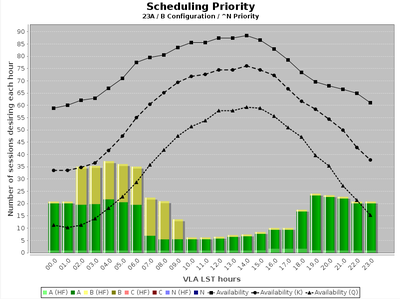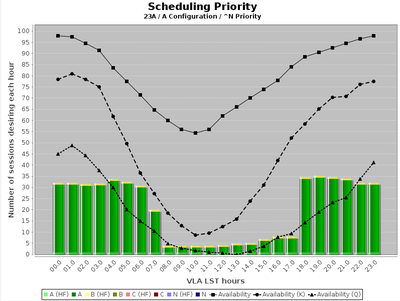VLA Proposal Guide
VLA Configuration Plans and Science Time Available
The August 1, 2022 deadline nominally covers the observing period January 19, 2023 through October 9, 2023 (Semester 2023A), encompassing the B and A configurations of the VLA. Multi-configuration proposals that include either of these two configurations may also be submitted. Additionally, proposals requesting only configurations that will fall in semester 2023B (or later) may be submitted if the Principal Investigator is a graduate student. NRAO offers this service to provide scientific and technical feedback for students, and to provide them with an opportunity to re-submit their proposals for their principal semester with this information in hand. Students should ensure that their status is up to date and correct in the NRAO User Database. Please refer to the VLA Configuration Plans for details and availability of upcoming configurations.
The plots of estimated available observing hours as a function of LST for the B and A configurations in semester 2023A are shown below. In these plots, engineering, maintenance, and testing cause the solid (upper) line to be less than the total number of LST days in each configuration; such activities occur predominantly during daytime. Also subtracted from the total available science time estimate for the B-configuration is the 658 hours allocated for the VLA Sky Survey (VLASS).
Estimated science time available per LST hour is shown by the solid (upper) black line for all frequencies, the dashed (middle) line for K-band conditions, and dotted (lower) line for Q-band conditions. The colored bars show pre-committed time where green represents priority A and yellow priority B. The lighter green and yellow represent high frequency (HF; K through Q bands) priority A and B, respectively. There is no red shown because there is no priority C pre-committed time this semester. For the net available time in each configuration per LST hour subtract the bars of the pre-committed time from the black curve. The pre-committed time in these plots consists of A-priority not completed in the previous B and A configurations and proposals from previous semesters that requested future configurations. This latter category includes the VLA extra-large proposal that has been approved for 206 hours in B configuration and 374 hours in A configuration in semester 2023A. More details on the VLA extra-large proposal (X-proposal) may be found in the NRAO eNEWS.
Observing Capabilities for Semester 2023A
For the 2023A semester the General Observing (GO) capabilities are given in the Offered VLA Capabilities during the Next Semester section of the Observational Status Summary (OSS) and are summarized in the following table. Several additional capabilities are available to proposers through the Shared Risk Observing (SRO) and Resident Shared Risk Observing (RSRO) programs, as described below.
| Capability | Description |
|---|---|
|
8-bit samplers |
Standard full polarization default setups for:
Flexible setups for spectroscopy, using two, independently tunable, 1 GHz baseband pairs, each of which can be split into up to 32 flexibly tunable subbands. Single, dual, and full polarization products for non-default setups. *Note: 4-band and dual 4/P-band observations are offered for Stokes I continuum only using standard full polarization default setups. Spectral line and/or polarization science carried out in these bands, or the use of non-standard setups, should to be submitted as a RSRO proposal. |
|
3-bit samplers |
Standard full polarization default setups for:
Flexible setups for spectroscopy, using four, independently tunable, 2 GHz baseband pairs, each of which can be split into up to 16 flexibly tunable subbands. Single, dual, and full polarization products for non-default setups. |
|
Mixed 3-bit and 8-bit samplers |
Allows more flexibility for simultaneous continuum and high-resolution spectral line observing |
|
Subarrays |
Up to 3 independent subarrays using standard 8-bit continuum setups (only one 8-bit continuum setup per subarray). |
|
Y27 or Y1 for VLBI |
VLA Phased Array (Y27) or single VLA antenna (Y1) for VLBI. See the VLBA Call for Proposals for more details. |
|
Solar observing |
All solar observing except the L-band reverse-coupled system |
|
On-The-Fly Mosaicing (OTF) |
P-, L-, S-, and C-bands only; no subarrays |
|
Pulsar |
Phase-binned and coherent-dedispersion (YUPPI) pulsar observing, except 4-band YUPPI |
Both single pointing and mosaics with discrete, multiple field centers are supported. Data rates up to 60 MB/s (216 GB/hour) are considered GO. Correlator integration time limits per band and per array configuration also apply as described in the OSS. The data rate and total data volume required by a proposal will be a consideration in its technical evaluation.
There are some limitations on frequency settings and tuning ranges, especially at Ka-band; please consult the OSS for further details. Additionally, the Exposure Calculator is available to estimate sensitivities, while other special tools are available to assist users with the development of correlator setups for the proposal deadline (see VLA Proposal Submission Guidelines). All antennas employ electronics and receiver systems that provide continuous frequency coverage from 1–50 GHz in the following observing bands: 1–2 GHz (L-band); 2–4 GHz (S-band); 4–8 GHz (C-band); 8–12 GHz (X-band); 12–18 GHz (Ku-band); 18–26.5 GHz (K-band); 26.5–40 GHz (Ka-band); and 40–50 GHz (Q-band). In addition to these, all VLA antennas are equipped with 200-500 MHz (P-band) and 54-84 MHz (4-band) receivers near the prime focus.
We continue to offer shared risk programs to our user community for those who would like to push the capabilities of the VLA beyond those offered for general use.
VLA Shared Risk Observing
The VLA Shared Risk Observing (SRO) program allows users access to capabilities that can be set up via the Observation Preparation Tool (OPT) and run through the dynamic scheduler without intervention, but are not as well tested as GO capabilities. Data rates higher than 60 MB/s (216 GB/hour) and up to 100 MB/s (360 GB/hour) are considered SRO. The following capabilities are offered under the SRO program during this semester:
- Up to 3 independent subbarrays using standard 3-bit continuum setups, or a mix of standard 3-bit and standard 8-bit continuum setups, and up to 3 independent subarrays with changing standard continuum setups in a given subarray (e.g., to perform reference pointing at X-band for high frequency observations).
- On-the-Fly (OTF) mosaicing for X-, Ku-, K-, Ka-, and Q-bands (used when each pointing on the sky is no more than a few seconds), but not using subarrays.
- eLWA: Joint LWA and VLA 4-band observations using a single 8 MHz subband centered at 76 MHz, and 4-bit VDIF output.
See the VLA Proposal Submission Guidelines web page for information about tools and other advice on proposing for Shared Risk observing capabilities.
VLA Resident Shared Risk Observing
The VLA Resident Shared Risk Observing (RSRO) program provides access to extended capabilities of the VLA that require additional testing. This access is provided in exchange for a period of residence to help commission those capabilities. Examples of capabilities that would fall under the RSRO program in this semester include:
- correlator dump times shorter than 50 msec, including integration times as short as 5 msec for transient detection;
- data rates above 100 MB/s;
- recirculation beyond a factor of 64 in the correlator;
- 4-band polarization or spectral line;
- 4-band coherent-dedispersion (YUPPI) pulsar observing;
- subarray observations with setups other than the default continuum setups, or observations with more than 3 subarrays;
- complex phased array observations (e.g., pulsar and complex VLBI observing modes);
- Frequency averaging in the correlator‡, including setups with mixed subband bandwidths, e.g., for spectral line+continuum with the averaging used in subbands designated for continuum;
- Rapid response capability: Automatically scheduling VLA observations in response to a trigger on shorter timescales than standard triggered proposals;
- eLWA: Joint LWA and VLA 4-band observations and correlations using options other than offered under SRO (e.g., a different center frequency, 16 MHz bandwidth, and/or 8-bit VDIF output for a higher dynamic range).
‡While frequency averaging by a factor of 2 or 4 was offered as GO in the past, our operational experience suggests that it is best offered as RSRO at this time.
A detailed description of the VLA RSRO program is available at the VLA Proposal Submission Guidelines web page.
Commensal Observing Systems at the VLA
There are currently two commensal systems in operation on the VLA that may take data at the same time as your proposed observation. The first is the VLITE system, which will take data at P-band during regular observations that use bands other than P-band. Hence, VLITE is turned off by default during P-band or dual 4/P-band observations. The VLITE system is deployed on up to eighteen VLA antennas. Observers wishing to gain access to the commensal VLITE data taken during their VLA observations should follow the instructions on the VLITE web page for doing so. The second is the realfast system, which takes data at very fast dump rates in an effort to detect Fast Radio Bursts (FRBs). This system is fully commissioned for observing at L- through X-bands, in parallel with standard continuum correlator configurations. A third commensal system, COSMIC SETI, is expected to become operational at the start of the 2023A semester. This system enables the search for extraterrestrial intelligence (SETI) using the VLA, and will collect data during unconflicted PI science observations. For information about commensal observing see the Commensal Observing with NRAO Telescopes page.
Proposal and Observation Preparation
Proposal preparation and submission are via the Proposal Submission Tool (PST) at NRAO Interactive Services. Use of the PST requires registration in the NRAO User Database. There are various tools and documentation to help users in this process. Descriptions of all updated documentation and tools, along with an outline of the steps required to write a proposal, are available at the Guide to Proposing for the VLA web page.
When constructing sessions in the PST, proposers should be cognizant of their use by the Telescope Time Allocation Committee (TAC). Specifically taking into account the time available as a function of LST, software will assign an initial scheduling priority to each session in each proposal, which can be modified by the TAC if they desire. The assigned scheduling priority will depend on the linear-rank score of the proposal from its scientific review, the LSTs involved in the session (daytime is harder to accommodate than nighttime, for instance), the predicted atmospheric conditions for observing over that LST range at the time of year of the configuration, the total time requested in the session, and the competition from other proposals requesting time at similar LSTs. Please see this description for guidance on how to set up sessions in the PST, and this document for a complete description of the VLA Prioritizer (the software that generates the initial scheduling priorities for all sessions that are subsequently used by the TAC to derive the final priorities).
All approved VLA observations are set up using the Observation Preparation Tool (OPT). Most projects will be observed dynamically; users granted dynamic, non-triggered time, must either submit their scheduling blocks before the start of the configuration or contact the VLA Scheduler (schedsoc@nrao.edu) before that date to avoid a reduction in scheduling priority. Early submission maximizes the opportunity of them being observed and helps us to schedule the VLA most efficiently. Advice on the optimal length of scheduling blocks and other useful information may be found at the Observing FAQ web page.
Information about VLA capabilities, proposal preparation and submission, observing strategies, and calibration overhead can be found in the VLA Observational Status Summary, at the Guide to Proposing for the VLA, and at the Guide to Observing with the VLA. Answers to Frequently Asked Questions are contained in these proposing and observing guides. Questions may also be directed to the NRAO Helpdesk.






Connect with NRAO